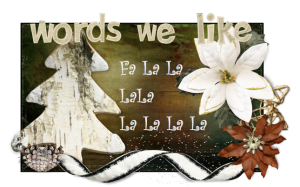YOU THINK THEY KNOW THAT WORD…..BUT DO THEY REALLY KNOW IT?
“Was the night before Christmas, and all through my house, not a teacher was mixing, not even the mouse,” said with confidence by a six year old in AVT. Mixing – stirring…..same thing. Teacher – Creature….not quite!
GIFT GIVING WORDS: Presents, gifts, ribbon, bow, gift bag, tissue paper, tape, double sided tape, tape dispenser, cards, tags, generous, Thank you, for me?, I like it (even if you don’t), surprise!
CHRISTMAS WORDS: Celebration, December, tree, artificial tree, assemble, ornaments, garland, tinsel, lights, colored/blinking/flashing lights, tree skirt, star, angel, electric candles, christmas cookies, Christmas Eve, Christmas Morning, Stockings, stocking stuffers, coal, decorations, holly, jingle bells, midnight, wishes
CHRISTMAS FOOD WORDS: Cookies, carrots, milk, eggnog, cranberry sauce, feast, festival, fruitcake, goose, gravy, greens, ham, gingerbread, Guests, figgy pudding, sugar plums
SANTA WORDS: Ho-ho-ho!, Santa, Mrs, Claus, Saint Nick, Father Christmas, Kris Kringle, Papa Noel, Reindeer, Rudolph, Comet, Cupid, Donner, Blitzen, Dancer, Dasher, Prancer, Vixen, hooves, elves, North Pole, sleigh, sack, sleigh bells, roof top, chimney, beard
DESCRIBING WORDS: Awe, beautiful, Aroma, bright, lovely, cozy, freezing, glowing, glistening, homemade, jingling, jolly, merry, naughty, decorative, frosty
NATIVITY WORDS: Manger, Stable, Inn, trough, Three Wise Men, shepherds, sheep, donkey, Mary, Joseph, the babe, infant, Christ Child, Emmanuel, Savior, Jesus, Angel, Gold, Frankinscense, Myrrh, camels, Advent, Faith, worship
HANUKKAH WORDS: Dreidel, (nun, hey, gimmel, shin), Maccabees, menorah, Star of David, synagogue, Temple, oil, Faith, 7 days, 8 nights (counting), fire, candles, wax, gifts, presents, small presents, big presents., Latke, kugle.
NEW YEARS WORDS: Resolution, priorities, count down, ball drop, times square, confetti, noise makers, party hats, “turn a new leaf,” “fresh start”
And if you know any Kwanza words….please add them in the comment field.
Happy Holidays!

 When the child with hearing loss uses an FM system in school, s/he is given direct access to the teachers voice, no matter how noisy the classroom or where the teacher is located.
When the child with hearing loss uses an FM system in school, s/he is given direct access to the teachers voice, no matter how noisy the classroom or where the teacher is located.